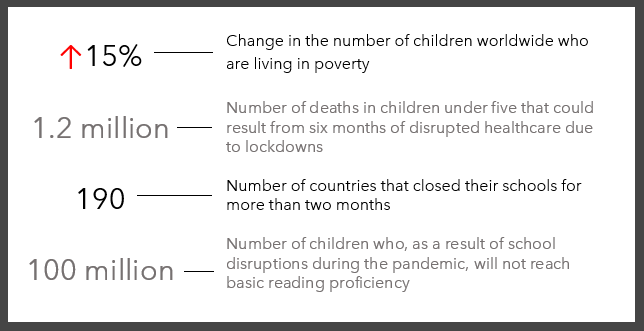Global Perspective: Children at Risk
Millions of children worldwide have been forced into poverty, with devastating effects


The COVID-19 pandemic and restrictive mitigation policies have forced millions of children worldwide into poverty, with devastating effects on their access to education, nutrition, shelter, sanitation, and overall likelihood of survival.
Before the pandemic, children were already disproportionately affected by poverty. Despite comprising only 1/3 of the world’s population, over half of those living in extreme poverty were children, subsisting on less than $1.90USD per day. Over the course of the pandemic, families teetering on the financial edge have been plunged into poverty by lack of access to healthcare, travel restrictions, and loss of employment. As a result, the number of children living in multidimensional poverty – meaning they lack basic necessities – has soared by 15% to 1.2 billion, according to a UNICEF and Save The Children analysis.
That’s an additional 150 million impoverished children.
Inaccessible healthcare
In a world where 800 million people spend at least 10% of their household income on healthcare, even a modest increase in healthcare needs could force the most vulnerable to choose between food or medicine. And that is assuming they are even able to access care. While children are unlikely to die from COVID-19, they are far more likely to suffer from the inability to access essential health services, whether because the clinics themselves are closed or because they can no longer visit them freely. Early in the pandemic, Roberton et al. estimated that the resulting disruptions to essential healthcare for populations already suffering the effects of malnutrition could see an additional 1.2 million children die before their fifth birthday.
Missed routine vaccinations
With the lions share of global resources funnelled toward COVID-19, the battles against more familiar enemies have been set aside, with deadly consequences. Data from the World Health Organization shows that routine immunization campaigns are still interrupted in 50 countries, putting an estimated 228 million people – mostly children – at risk from life-threatening diseases, including measles, yellow fever and polio. More than half of the affected countries are in Africa, where many parents already struggle to get their children basic levels of healthcare and nutrition, rendering them far less likely to survive disease. Measles is particularly contagious and requires high levels of vaccination to prevent outbreaks. In 2019, measles was responsible for over 200,000 deaths worldwide, most of whom were children. The news that severe outbreaks are now being reported among those left unvaccinated in the Democratic Republic of Congo, Yemen, and Pakistan are concerning.
Disrupted education
Save the Children have called the pandemic “the biggest global education emergency of our lifetime“. By the end of April 2021, half the world’s children, almost 175 million, remained affected by complete or partial school closures. In over 190 countries, schools were closed for more than two months – some for an entire year. UNESCO estimated that as a result of the pandemic, the number of children who will not reach basic reading proficiency could surge by an additional 100 million, which will impact their earnings potential and opportunities for the rest of their lives. Even where online learning is available, remote instruction does not work well for the youngest learners. It reinforces the gap between rich and poor, i.e. it disadvantages children without access to computers, the internet, somewhere quiet to work, and in-person support.
In the world’s most impoverished communities, children whose schools close their doors are at risk of exploitation – being forced into unsafe child labour or early marriage to ease the family finances. It has been estimated that between seven and 9.7 million children who stopped attending school during the pandemic will never return.

Further reading
- As COVID-19 devastates already fragile health systems, over 6,000 additional children under five could die a day, without urgent action. UNICEF, 12 May 2020. https://www.unicef.org/press-releases/covid-19-devastates-already-fragile-health-systems-over-6000-additional-children
- COVID pushes millions more children deeper into poverty, new study finds. UN News, 17 Sept 2020. https://news.un.org/en/story/2020/09/1072602
- COVID-19: Have we forgotten our children in all this? Oxford Centre for Evidence-Based Medicine, 14 May 2020. https://www.cebm.net/covid-19/covid-19-have-we-forgotten-our-children-in-all-this/
- The Covid-19 pandemic and children 5 months on. Save the Children, 13 August 2020. https://www.savethechildren.org.uk/blogs/2020/the-covid-19-pandemic-and-children-5-months-on
- Education: From disruption to recovery. UNESCO, 30 April 2021. https://en.unesco.org/covid19/educationresponse
- Immunization services begin slow recovery from COVID-19 disruptions, though millions of children remain at risk from deadly diseases – WHO, UNICEF, Gavi. WHO, 28 Apr 2021. https://www.who.int/news/item/26-04-2021-immunization-services-begin-slow-recovery-from-covid-19-disruptions-though-millions-of-children-remain-at-risk-from-deadly-diseases-who-unicef-gavi
- 150 million additional children plunged into poverty due to COVID-19, UNICEF, Save the Children say. UNICEF, 16 September 2021. https://www.unicef.org/press-releases/150-million-additional-children-plunged-poverty-due-covid-19-unicef-save-children
- WHO urges countries to build a fairer, healthier world post-COVID-19. WHO, 6 April 2021. https://www.who.int/news/item/06-04-2021-who-urges-countries-to-build-a-fairer-healthier-world-post-covid-19
